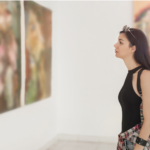
Where You Can Discover Modern Art in Gungahlin
There’s no denying that modern art is a groundbreaking genre. But, what is it? And where can you find it or make it around Gungahlin?
Understanding modern art
To understand the evolution of modern art you need to travel back to the Industrial Revolution (c.1760-1860). The 19th century was a time of significant and rapid change and this affected how people lived, worked and travelled. Towns and cities swelled and prospered and social changes led to more demand for urban architecture, applied art and design. The emergence of a new class of wealthy entrepreneurs saw an increase in art collectors and patrons and many new art museums were founded. Photography saw some major advances, allowing artists to photograph scenes and then paint them in their studio at a later date. Both of these developments led to a new style of painting – “impressionism”.
Up until this time artists largely followed the Hierarchy of the Genres – religion, Greek mythology, portraits and landscapes. All of a sudden artists began to make art about people, places or ideas that interested them and modern art was born. Artists were no longer commissioned to make artwork by wealthy patrons or institutions like the church – they were coming up with their own ideas and basing their art on their own experiences. Many artists began exploring dreams, symbolism and personal iconography as avenues for the depiction of their subjective experiences. Others experimented with non-traditional materials, new colours and different techniques and mediums.
The seven major movements of modern art
Modern art composed of seven major movements and set the scene for creativity and whimsical magic…
Impressionism (1870s): Widely considered the catalyst for modern art, it challenged the rigid rules and realistic depictions of academic painting. Claude Monet’s work is a great example.
Post-impressionism (1890s): Inspired by the artistic freedom of impressionism, post-impressionism showcases an interest in emotion and a preference for subjective interpretation over realistic representation. Vincent van Gogh’s Starry Night is a great example.
Fauvism (1900s): Founded by les Fauves, an avante-garde group of French artists including Andre Derain and Henri Matisse, Fauvism favoured unrealistic and intense tones and an emphasis on individual perceptions and abstracted forms. Henri Matisse’s The Joy of Life is a great example.
Expressionism (1910s): Shortly before World War 1, painters in Germany and Austria began experimenting with their approach of other modern movements. The style conveyed a fascination with bright, artificial colour and individualistic iconography. Franz Marc’s Blue Horses is a great example.
Cubism (1910s): Characterised by deconstructed, fractured forms, cubism was a shift toward abstraction. It pioneered topsy-turvy paintings, multi-dimensional sculptures and creative collages. Pablo Picasso’s The Weeping Woman is a great example.
Surrealism (1920s): Rooted in the subconscious, surrealism lacked any control exercised by reason. It was exempt from aesthetic and moral concern and culminated in dream-like depictions straight from the imagination. Salvador Dali’s The Persistence of Memory is a great example.
Abstract expressionism (1940s): Committed to expressions of profound emotion, abstract expressionism encouraged interest in myth and archetypal symbols – a struggle between self-expression and the subconscious mind. Jackson Pollock’s The Moon Woman is a great example.
Where to find modern art in Gungahlin
Modern art might have ended in the mid 20th century but it opened the door to a new form of modern art, one where there are no rules in which to follow. Artists are encouraged to explore whatever comes to mind and here in Gungahlin we’ve got some fine examples of modern art to explore. Many of these come in the form of sculptures…
Lady with Flowers
Artist: Dean Bowen
Lady with Flowers is a figurative bronze animated lady located on Flemington Road, Gungahlin. She’s the second public art piece for local artist Dean Bowen – the first being Little Big Man. Some say that her location by a bus stops means she’s off to visit her bronzed counterpart.
With whimsical naivety, the Lady with Flowers captures the attention of all-ages. She was funded by Land Development Agency and Roads ACT.
Ginninginderry Light
Artist: Geoff Farquhar-Still
The Ginninginderry Light (an Aboriginal term for “sparkling”) is an elegant stainless steel structure embedded with millions of tiny reflective glass beads designed to reflect light from the sun, the moon and passing cars. It was commissioned by CIC Crace Pty Ltd and can be found in the Crace Pedestrian Plaza.
Gungahlin Drive Extension Artworks
Artist: Richard Goodwin
The objectives of the Gungahlin Drive Extension Public Art Program were to enhance the driving/riding experience and respond to the characteristics of the urban, natural and community environments. There are five different aspects to the public artwork. Artist Richard Goodwin worked collaboratively with a team of four Indigenous representatives to produce the works, including a local Ngunnawal artist.
Alexander Bunyip
Artist: Anne Ross
Alexander Bunyip is a character from the popular 1972 children’s book, The Monster That Ate Canberra. Artist Anne Ross playfully shows the bunyip with his trusty travel case in Gungahlin Town Park.
Creating your own modern art in the Gungahlin region
If you feel like creating your own modern art, Belconnen Community Service and Northside Community Service will run a 10-week Open Art Program called “Gungahlin Impressions”, aimed at creative people who live in the Gungahlin region. Participants can choose whatever art style they want, so why not take inspiration from the above and think outside of the rules? You can work individually or in collaboration with another participant. The 10-week art program starts on Wednesday 27 September and ends on Wednesday 29 November.
For more art inspiration pop into Book Face where you’ll find a huge range of art books and a varied, quirky and interesting range of giftware. You can find Book Face and more at Market Gungahlin.

